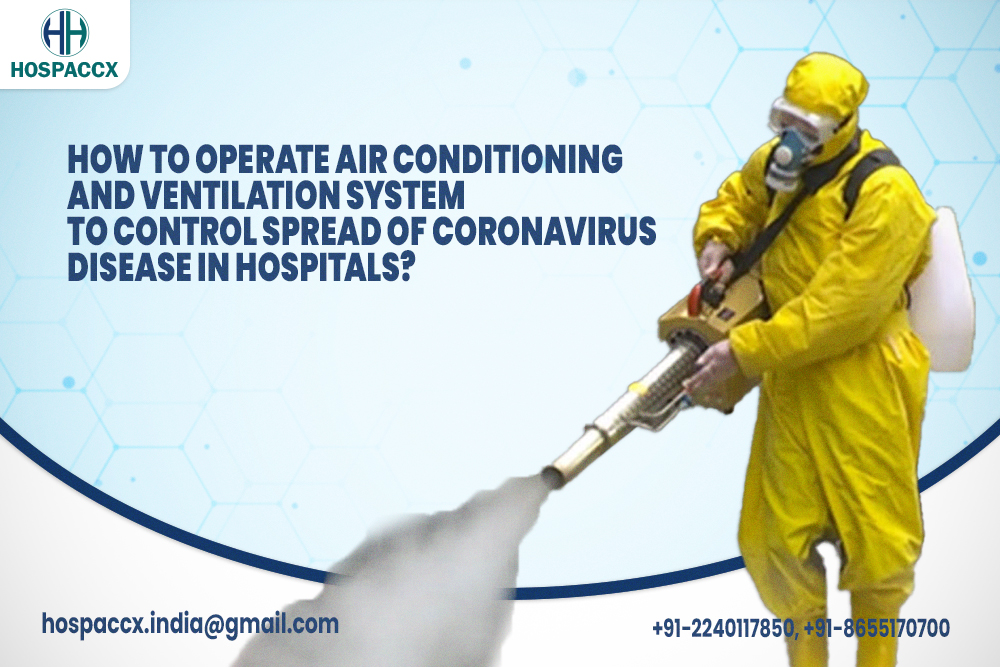HOW TO OPERATE AIR CONDITIONING AND VENTILATION SYSTEM TO CONTROL SPREAD OF CORONAVIRUS DISEASE IN HOSPITALS?
In this article Hospaccx Business Healthcare Consultancy Pvt. Ltd. Summarizes and advice on how to operate the HVAC system in the COVID-19 hospitals to prevent the spread of coronavirus disease (COVID-19). If you need a refined market and financial feasibility or any other study related to healthcare, you can contact Hospaccx Healthcare Business Consulting Pvt. Ltd on hospaccx.india@gmail.com
INTRODUCTION
COVID-19 is a communicable disease caused by a newly discovered coronavirus. Most people infected with the COVID-19 virus will experience mild to moderate respiratory disease and recover without requiring special treatment. The COVID-19 spreads primarily through droplets of saliva or discharge from the nose when an infected person coughs or sneezes.
COVID-19 has truly caused havoc around the world by causing more than 21 lakh deaths all across the globe within 5 months. The worst countries which are affected by the pandemic are India, Italy, USA, Spain, and other European countries. The healthcare industry is growing at a very faster pace, owing to its strengthening coverage, services, and increasing expenditure by public as well as private players.
Coronavirus can be spread through the droplets, direct contact, indirect contact (touchable areas), facial oral, and it’s an airborne disease. Closed environments with minimum ventilation strongly contribute to a characteristically high number of secondary infections. Transmission of viruses can be limited by changing air temperature and humidity levels. The toilets need to be installed with the closed windows. Room pressurization, air change rates, humidity, and temperature all play an integral role in mitigating airborne contaminants to provide a healing space for patients while also providing a high level of protection for healthcare personnel.
HVAC maintenance department plays a crucial role in maintaining the temperature indoors. The engineers need to be skilled with proper training. The duct needs to be cleaned every day so that the virus shouldn’t enter through the air. When an infected coughs or sneezes, respiratory droplets can travel through the air and be inhaled by the people nearby. So, it’s critical to make sure airborne infection controls are working properly. Infectious disease can be spread through several routes including the air transmission. To control the transmission of infectious disease in the hospital proper HVAC systems need to be designed and maintained.
Some of the Hospital prefers using minimum Efficiency Reporting Value (MERV) which can remove 75 percent of particles ranging from 0.3 to 1.0-micron size, while some of the others prefer HEPA filters as the final filters which can remove more than 99.9 percent of these particles. The coronavirus itself is between 0.06 and 0.14 microns in size. Viruses are expelled through droplets of saliva that present themselves as larger particles when they encounter a filter. Based on the CDC recommendations, HEPA filtration can help prevent the spread of the coronavirus. To successfully use HEPA filtration in the HVAC system, the HEPA filters need to be designed into the HVAC system and air handling unit. Specifically, the HEPA filters need to be fitted tightly fitted in the HVAC. Maintaining the hospital’s environment of a relative humidity level between 40 and 60 percent has been documented to decrease the survivability of the virus.
Following Tips for verifying Airborne Infection Isolation Rooms can be taken into consideration:
- Verify the room sensors are calibrated and working properly
- Ensure room controllers and monitors are working and communicating with supply and exhaust airflow valves
- Verify the room is operating at a negative pressure relative to surrounding areas and ensure room pressure is being properly documented
- Verify correct air changes per hour are taking place per CDC/ASHRAE standards
- Confirm temperature and humidity ranges are in place per CDC/ASHRAE standards
- Verify room air is being exhausted directly outside through a HEPA filter
- Ensure doors are being kept closed except during healthcare personnel entry/exit
- Confirm patient rooms are visible on your building automation system, for prompt notification of any issues
- Consider updating older supply and exhaust VAV boxes to fast-acting Venturi air valve or measure airflow valve
- Plan for an influx of patients and how to address isolation requirements in your facility
The temperature inside the COVID-19 hospitals needs to be maintained. The temperature needs to be 24°c – 30°c needs to be maintained inside the COVID-19 Hospitals. The hospital should have high temperatures and humidity to maintain. China indicates that high temperature and high humidity significantly reduce the transmission of coronavirus disease through air.
The Following process is recommended at the start-up of the AC:
- Open all the doors and windows of the space.
- Ensure that all cleaning protocols are complete.
- Run the fresh air system at the maximum intake of air setting.
- Start and run the exhaust systems.
- Start the air conditioning system in fan mode only, without filters, and rum it for a minimum of two to four hours with doors open and exhaust system operational.
- Install the clean & sanitized filters.
- Start the AC in normal mode and run for two hours with doors open and then close the doors and windows.
Air Recirculation in HVAC & Heating Systems
Since the SARS-CoV-2 particles can remain in exhaust ducts, it is essential to avoid air recirculation in HVAC systems to prevent COVID-19:
- In Air Handling Units that take advantage of the air and recirculation, the mixing sections must be closed even if they have filters (since these are non-HEPA filters that let SARS-CoV-2 microparticles through);
- Ventilation fans must be switched off or, if this is not possible, they must be thoroughly disinfected;
- Heat exchangers and heat recovery devices must be switched off, except for systems that can fully separate the intake and return air;
- Air purifiers only work in very small rooms (<10 m2) and therefore only provide benefits if they are installed very close to people – overall, adequate space ventilation offers many more benefits;
- You should install HEPA filters in windowless rooms and in closed circuits, which are the only ones capable of filtering out virus microparticles.
- There is no advantage in doing additional duct cleaning as long as you avoid 100% of air recirculation and ventilate the rooms. Clean and sanitize the ducts as planned.
- Replace the filters only when they have exceeded their usable time or there is a break in the load input. There are no advantages in changing it more often if there are no malfunctions in the filter performance.
- There is no need to change the external filters as current ventilation systems have F7, F8, or ISO ePM1 filters. If you have any questions, please see the technical details of the equipment to confirm.
- Maintenance personnel should wear masks, goggles, and gloves to replace the filters, as they can reservoirs for the virus. You should always assume, even in normal public health situations, that the filters have potentially contagious microbiological material.
- The filters must be stored in sealed bags.
- Ionization or UV disinfection is not recommended for common buildings and only makes sense in a hospital setting.
OPERATING GUIDELINES THAT NEEDS TO BE FOLLOWED BY THE HOSPITALS
- Air Filters must be kept clean as given in the Section – Operation & Maintenance.
- Provide adequate Ventilation (Fresh Air and Exhaust).
- Inspect and clean the indoor unit Coils, as given in the Section – Operation & Maintenance.
- Set Room Temperature between 24°C and 30°C. Maintain a relative humidity between 40% and 70%. (In humid Climates set temperature closer to 24°C for dehumidification and in Dry Climates closer to or at 30°C Use Fans to increase air movement)
- Heat Recovery Wheel (HRW): It is advisable to keep this wheel in off mode to reduce cross-contamination. Upon restarting, the wheel must first be sanitized.
- Toilet and Kitchen Exhaust Fans must be kept in operating mode.
To convert an existing patient room or ICU into a COVID-19 patient area, it’s first necessary to convert the space into a non-recirculatory system. On an emergency basis, this will be achieved by blanking (blocking) of the return air vents within the COVID-19 patient room. It’s important to form sure that the AHU will have provisions to receive adequate outdoor air supply. The outdoor air source for the AHU shall not be from within the building and everyone care shall be taken to avoid intake of outside contaminants, to the best possible extent. Additionally, an independent exhaust blower shall be provided to extract the space air and exhaust out into the atmosphere, preferably, after suitable “exhaust air treatment”. The exhaust air quantity shall be greater than the availability air quantity such a negative pressure of minimum 2.5Pa (preferably >5 Pa) is achieved within the room. It’s advisable to put in differential pressure meters to live this metric. The availability air quantity shall be such it’ll provide a minimum of 12 air changes per hour. The position of the extract air in the room shall be just above the top of the patient’s bed.
CONCLUSION
This study concludes that following the proper guidelines and maintaining the proper HVAC system in the hospital can reduce the spread of coronavirus through the transmission of air. As the coronavirus is an airborne disease that can be spread through the air, proper HVAC can be introduced to stop the spread of coronavirus.
If you need any support in Planning and Designing a new Hospital you can contact us: Hospaccx healthcare business consulting Pvt. Ltd on: hospaccx.india@gmail.com
Related Team Members









